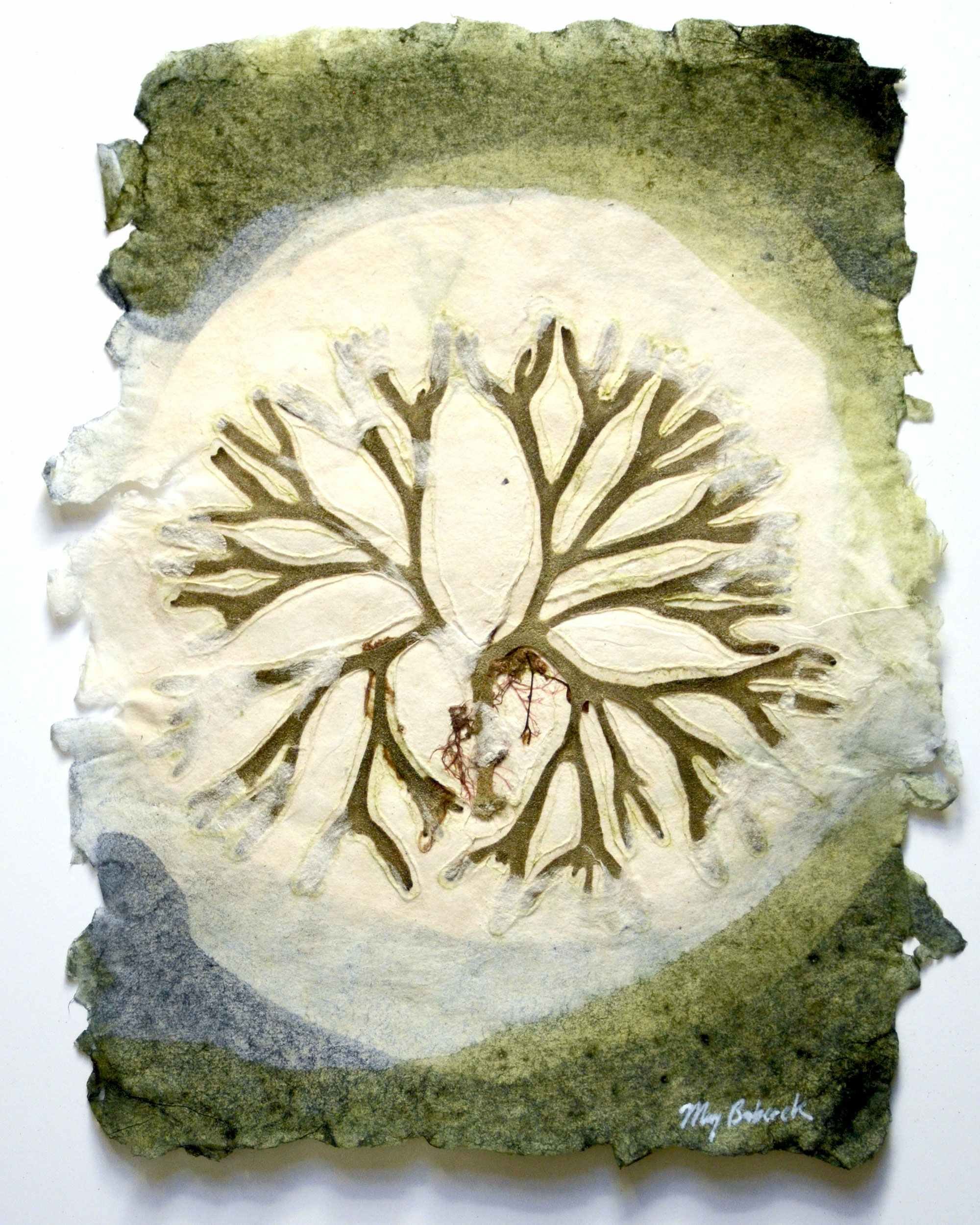Seaweed papers
I enjoy wandering New England coastlines to collect seaweed for 1.) hand-making paper out of seaweed, 2.) flattening into pressings, and 3.) extracting natural dye color. Each artwork yields an extraordinarily detailed view of ocean flora layered inside the paper.
This series re-contextualizes seaweed into contemporary art and life. My artwork acts as witness to changing ocean species and poignant evidence of human activity, all while celebrating the natural beauty and material realities of the living sea.
ROCKWEED
22 x 18 inches each, artist-made paper (made from Codium fragile seaweed, flax, rockweed, Szechuan banana), rockweed (Ascophyllum nodosum), bladderwrack dye, 2025
Along Rhode Island coastlines, I collected rockweed for pressing and pulping up into paper, a so-called “invasive” seaweed Codium fragile for paper pulp, and bladderwrack for natural seaweed dye.
These works also reference the decaying, pitted shells that I find.
Sea of Secret Colors
9 x 6 inches, artist-made paper (linen rag, flax, abaca), seaweeds, inks from turmeric and indigo, 2022.
After wading around Narragansett Bay and loving the experience of seeing seaweed flowing free in the salt water, I embedded the found seaweed within paper pulp. I painted handmade inks to recall the experience.
Bladderwrack Prints
9 x 6 inches, artist-made paper (linen rag, flax, abaca), seaweeds, bladderwrack eco-print, 2022.
By accident I discovered a new way to create an eco-print. Pressed seaweed next to wet handmade paper imparted its shape and color after a couple days.
Rhode Island Herbarium
12 x 17 inches, 2018 - 2021, Artist-made paper (from linen rag, artist-grown flax, abaca, cotton paper waste), seaweed, pondweed, gilded metal leaf.
I am inspired by the beauty found in aquatic plant and macroalgae species, some living in the waters for a long time, and some originating from other waters and oceans across the earth—having traveled via various natural and human transportation methods.
I work towards correct identification of seaweed and pondweed species, through changing lifecycles, seasons, and locations, and also research their ecological roles and human uses in the past and present. I am continually surprised by what I find washed up through different times of the year. Along Rhode Island’s shores, I do find masses of seaweed blooms and ecologically troublesome species—results of human activity causing an imbalanced ecosystem.
The hand lettering in gilded metal leaf indicates a mix of the colloquial, Google Maps, and researched Indigenous names of the collection sites to express the complexities and diverse histories in our landscapes. Many Algonquian place names are prominent in New England, and the First Peoples of Rhode Island have persevered through centuries of colonization. Place names reflect this history, and situations where the name changed to Euro-centric names or have kept Indigenous names or their variations, derivations, and summarizations. Prior to colonization, all Rhode Island waters and lands were territories of Narragansett, Wampanoag, Nehântick, Nipmuc, and Pequot First Peoples. Following their examples, wisdom, and resilience, I encourage ecological citizenship in relationship to your local waters, lands, and living things.
This site specific and research based project touches upon vital issues surrounding ecosystems in the Narragansett Bay watershed, tying together the natural world with the ongoing relationships between people and place.
Weathering
Artist-made paper, seaweeds, copper leaf, Providence River water and Miracle Gro patina, 4 x 6 in., 2019-2020
Some waterways remain questionable to touch. On cut-down pieces of seaweed paper, I gilded copper metal leaf. With jars of collected Providence River water mixed with nitrogen-rich Miracle-Gro, the copper alchemized into blue and green patina colors. The drawings are inspired by historical waterway maps, including Great Salt Cove, a lost tidal marsh located in present-day downtown Providence, Rhode Island.
Macroalgae
9 x 6 inches, artist-made paper (linen rag, flax, abaca), seaweeds.
The first of the Seaweed Papers series, Macroalgae was an innovative identification method while researching aquatic plant and algae species for paper fiber in Rhode Island waterways.
Exhibited at:
Roger Tory Peterson Institute; T.F. Green Airport, Providence, RI; Society of Arts and Crafts, Boston, MA; Chandler Gallery, Montpelier, VT; Worlds Fair Gallery, Providence RI; Hamilton Gallery, Salve Regina University, Newport RI; City Hall Gallery, Providence, RI; Private Collections.
Resources
Learn more about the First Peoples of Rhode Island by exploring:
the First Peoples of Rhode Island Rhode Tour Curated by Katharine Kirakosian, PhD and Tomaquag Museum
Find information on the First Peoples of your location with Native Land Digital’s map of territories
Support and learn more from the Tomaquag Museum, which is Rhode Island’s only Indigenous museum “dedicated to sharing our culture, arts and history from a first person perspective.”
Seaweed Guides
A good beginner guide focused on commonly harvested Maine seaweeds can be found at the Maine Seaweed Council. Though Rhode Island is further south on the East Coast, I have found most of these listed species in my locale.
The Seaweed Site, a helpful and in-depth website about marine algae
For introduced aquatic species identification, browse the RI DEM resource page.
New England Water Species Identification from SECONN Skin Divers.









































